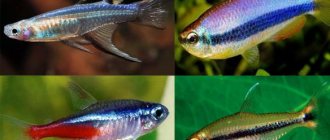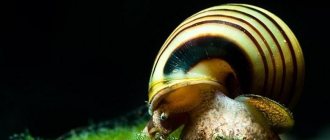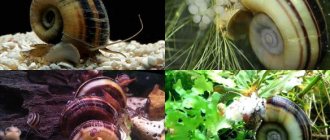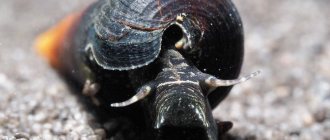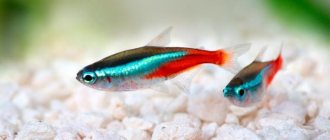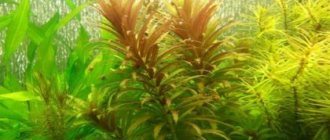In addition to beauty, an aquarium at home is also a concern. To make it easier to keep the aquarium clean, the Theodoxus snail can help: Fluviatilis; Pallasi; Danubialis; Transversalis; Euxinus; Astrachanicus. Of course, replacing water, trimming aquarium plants, sifting the soil and treating diseases falls on the owner of the aquarium.
The Theodoxus snail can help with some aquarium diseases by eating aquarium plants as food, thereby “trimming” them. There are several species of Theodoxus, we will talk about some of them.
Features and description
Theodoxus snails, despite their unusual appearance, live in reservoirs of the former post-Soviet space. Initially, this subspecies lived only in the seas, but gradually began to move to lakes and freshwater rivers. Theodoxus snails belong to the Neretida family.
Theodoxus snails are by no means as simple as they seem at first glance. These creatures, belonging to the order Gastropods , are very beautiful, have a variety of colors and interesting behavior patterns.
They are characterized by a rounded shell about 1 cm high . The color of theodoxus snails can vary from pale gray and greenish to black or rich olive tones. And on the surface of the shell there are various lines and specks, forming bizarre wavy patterns.
The walls of the shell are hard and durable. Nature itself made sure that the snails did not suffer when living in reservoirs with fast, strong currents and did not become easy prey for predators.
Appearance and color.
Theodoxus belong to the neritid family, measuring about 6.5 mm x 9 mm. The body and lid are light yellow, the sole or leg is white. The walls of the shell are thick, adapted to the turbulent currents of rivers in the natural environment. The shells themselves can be of different colors with a variety of patterns (white, black, yellow with dark zigzag lines, reddish-brown with white spots or stripes).
Theodoxus have gills and an operculum - this is a lid that covers the shell like ampullaria. On the back of the leg there are special caps that close the mouth of the shell.
Content Features
Theodoxus snails are rightly considered one of the easiest to use and unpretentious aquarium inhabitants. They can be kept either in a separate aquarium or in a common artificial pond. If you want to organize a so-called snail, you will need a very small tank with a volume of about 5 liters (based on 8-10 individuals).
As for the parameters of the aquatic environment, to create the most comfortable conditions, aquarists are recommended to adhere to the temperature regime, which should vary from +19° to +29°C. At the same time, the indicators of hardness and acidity are not particularly important.
The basic rule for keeping theodoxus snails is to maintain cleanliness in the artificial reservoir.
Therefore, once a week it is necessary to clean the tank itself and the decorative elements in it, and also take care of high-quality filtration. In addition, experts note that these mollusks are intolerant of carbon dioxide. An excess of this compound in the aquatic environment can lead to the death of pets. Stagnant water also has a negative effect on theodoxus snails, so it is important to promptly replace the fluid in the tank.
An artificial pond must be decorated with various driftwood, branches and stones (read more about how to make decorations for an aquarium). Such decor is required not only to create a spectacular aquarium design, but also for comfortable living of theodoxus, known for its pronounced territoriality. Each individual chooses a separate area in the reservoir, covered with a thin film of algae, which is the main type of food for these mollusks, and rarely moves to a new area. As a rule, voluntary resettlement may be due solely to lack of food.
Interestingly, while happily eating algae, theodoxus snails do not cause any harm to various green spaces, aquatic and aquatic crops planted in the aquarium.
These mollusks are excellent cleaners. So, having got such pets in a common artificial reservoir, you don’t have to worry about its cleanliness and tidiness.
Even in the absence of cleaning the back wall of the tank from the greenish coating that forms, the theodoxus snails quickly bring it to a spotless, perfectly clean state.
Snails can live in brackish water, but in fresh water their size becomes larger, the color of their shell becomes brighter, and their life expectancy is longer.
Habitat
Small snails live in Ukraine, Poland, Russia, Belarus and Hungary. They are also found in the Baltic countries and Scandinavia. There they live in rivers and lakes among submerged tree branches, stems of aquatic plants and stones. They eat algae and detritus from them. You can see theodoxus while walking near the water, as they often crawl onto land.
Some species live in the Black, Azov and Baltic seas. As scientists say, theodoxus initially lived in salty sea water, but then something forced some species to move to fresh water bodies, where they successfully live to this day.
Behavior and compatibility with aquarium inhabitants
Theodoxus snails are calm, peaceful and phlegmatic. They do not pose any threat to other aquarium inhabitants. The only thing that an aquarist should take into account is the parameters of the aquatic environment. The fact is that in order to form a durable and strong shell, snails require sufficient water hardness and the presence of calcium in it, which is not acceptable for every breed of fish. It is this point that should be taken into account when populating an aquarium with fish and snails.
Experts recommend keeping theodoxus snails in small flocks, acquiring at least 6-8 individuals at once. Despite the fact that mollusks lead a solitary lifestyle, with fewer numbers (due to their small size) they will simply be invisible in an artificial reservoir. In addition, this number is optimal for subsequent reproduction, since theodoxus snails can be either unisexual or heterosexual. And besides, it is simply impossible to visually distinguish males from females.
It is strictly not recommended to keep theodoxus snails in the same artificial reservoir with large predators.
Features of reproduction
An interesting feature of theodoxus snails is their ability to reproduce throughout the year. To do this, it is only necessary to maintain a certain temperature regime, which should be at least +24°C. The reproduction process itself occurs independently naturally and does not require third-party intervention.
Mollusks lay their eggs on various stones, driftwood and even the walls of the aquarium - any hard, durable surface is suitable for them. It is also interesting that the eggs themselves resemble a capsule in shape, which contains several small testicles.
After 1.5-2 months, only one baby is born, for which the remaining eggs serve as a source of food.
Theodoxus snails grow quite slowly. At first, babies with fragile shells, because of their defenselessness, prefer to hide from potential dangers by hiding in the ground. The maturation of an individual can be determined by its color, which becomes characteristic of a particular subspecies of theodoxus snails. Also, lines, spots and patterns that are visible to the naked eye gradually begin to appear on the shell.
As a rule, young individuals reach sexual maturity at an age of about 1.5-2 years. On average, the reproduction frequency of female theodoxus snails is once every 2-3 months. Due to the short life span of these gastropods and their slow growth, aquarists do not have to worry about possible overpopulation of an artificial reservoir.
Varieties
- Theodoxus danubialis (lat. Theodoxus danubialis)
It has a pleasant cream and white shell color with dark zigzag patterns. The maximum diameter of the rounded shell is 1.5 cm. They prefer hard water, so limestone stones are added to the aquarium where they live. They settle on rocky surfaces and are suitable for keeping in brackish water.
- Theodoxus transversalis (lat. Theodoxus transversalis)
The smallest snails of this genus. Their gray shell has no pattern; you can often pass by and not even notice this living creature.
- Pallasi (lat. Theodoxus pallasi)
Marine inhabitants of the genus Theodoxus. They chose the shallow waters of the Aral, Azov and Black Seas. Their size is about 1 cm in diameter, the color of the shell is yellowish with numerous dark specks.
- Theodoxus fluviatilis
The most common type. These snails have inhabited a vast territory: from Scandinavia to the Mediterranean Sea and from Western Europe to the Caspian Sea. There are both freshwater and marine subspecies. Their favorite places in everyday life are large flat stones, on the surface of which they rub algae, which serves as food, before eating. There are a lot of color variations of shells, the usual diameter of individuals is from 1 to 1.4 cm.
- Theodoxus euxinus
Lives in rivers of Southern Europe. These are very small gastropods with a shell size of up to 8 mm and bright purple lines on a light gray background.
- Theodoxus astrachanicus
It lives, as a rule, in the Dnieper, Dniester, bays and estuaries of the Azov Sea. The color of the shell is olive, with zigzag thin black stripes running across the entire surface. The size of individuals is also small: up to 1 cm.
Possible diseases and maintenance problems
Theodoxus snails are distinguished by excellent immunity, body stability and excellent adaptive abilities. Therefore, they rarely cause any trouble to their owners and are practically not susceptible to diseases characteristic of other aquarium inhabitants. Only stagnant, dirty water or an excess of carbon dioxide can cause the death of mollusks.
You don’t even need any special feeding for your pets; you just need to plant a sufficient amount of algae in the aquarium, which serves as a source of food for these cute creatures. Theodoxus snails will undoubtedly enjoy both green and brown algae. The only thing they do not eat is “blackbeard,” which upsets many aquarists who are tired of fighting this rapidly growing plant.
Surprisingly, these tiny creatures help aquatic and above-water crops, carefully clearing them of algae and without at all damaging the leaf blades, stems or rhizomes of higher plants.
Perhaps the main disadvantage is the short life span of theodoxus snails, which even under the most favorable conditions is no more than 2.5-3 years.
The main advantages of theodoxuses
According to most aquarists, theodoxus snails, in comparison with many other aquarium inhabitants, have a number of advantages:
- attractive appearance, in no way inferior to other exotic mollusks;
- ease of care;
- simple food;
- reproduction throughout the whole year;
- good and good health;
- calm and peaceful disposition;
- performing a cleaning function in the aquarium.
Theodoxus snails are very cute and cute creatures that do not require attention or special care. In addition to the fact that these mollusks are very friendly and attractive in appearance, they also perform a number of useful functions, cleaning an artificial reservoir from algae and plaque, without causing damage to the green aquarium plantings. It is thanks to these qualities that theodoxus snails have recently become increasingly popular among both beginners and experienced aquarists.
Diseases
Often snails suffer from the negligence of the owner or the aggression of other inhabitants of the aquarium. The human factor determines the following points:
- An overly clean or new aquarium . There will simply be no food for theodoxus in it, and the snails will die of starvation.
- Too soft water : lack of calcium will lead to softening of the shell and death of the snail.
- Wrong neighbors . Large predators are happy to diversify their diet at the expense of baby theodoxus.
- Too high a copper content in water is detrimental to shellfish.
- Poor aquarium aeration is bad for the health of babies.
- Improper conditions in the store . Before placing theodoxus in a community aquarium, the snail colony must be kept in quarantine. This measure will help the mollusks restore health.
Theodoxus is a small and very clean snail. Its reproduction rate is low, so there is no need to worry about overpopulation of the aquarium. It is easy to care for and is suitable even for a novice aquarist.


